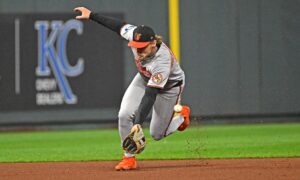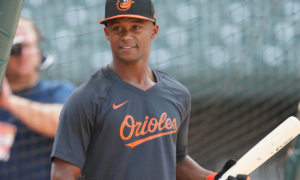SCROLL DOWN TO READ ARTICLE

Welcome to the first edition of Stats All, Folks.
This season-long series will provide a primer into the statistical side of baseball, focusing especially on analytics and advanced stats. Think of it as a crash course in sabermetrics.
If you’re a baseball fan who is fascinated by new ways of analyzing and thinking about the game, but can’t always keep track of every sabermetric stat and what it means, then you’ve come to the right place. Here you can dip your toes into the water rather than diving right into the deep end.
If you’re a die-hard traditionalist who will always hold a special place in your heart for batting average and pitcher wins, I encourage you to read on and keep an open mind. You might find sabermetrics to be much more relatable — and enjoyable — than you expected.
CONTINUE READING BELOW
If you’re an experienced sabermetrician who is already well-versed in baseball analytics, this series might not tell you anything you don’t already know. But keep reading anyway, and feel free to check my work.
To get started, let’s take a look at the stat that has perhaps become most closely associated with sabermetrics: WAR.
What is WAR?
WAR stands for Wins Above Replacement, and — in a nutshell — is designed to approximate a player’s overall value by boiling it down into a single number. Specifically, it attempts to answer the question: How many games does a player help his team win compared to a replacement player?
A replacement player, in this context, refers to a below-average major leaguer, the kind of guy who can fill out a Triple-A roster just fine, but is overmatched in the big leagues. You know the type. Picture a journeyman minor leaguer who hops from team to team without ever making an impact in the majors; a player your club could pick up off the scrap heap at a moment’s notice. Every organization in baseball has plenty of these players lingering in their system (and occasionally in the majors) at any given time.
CONTINUE READING BELOW
WAR uses this concept of a replacement player as a baseline for comparison. Last year, for instance, Baseball-Reference.com pegged Manny Machado as worth 6.7 WAR. That means that if Machado had missed the entire season and Joe Replacement had filled in for him all year, it’s estimated the Orioles would’ve won 6.7 fewer games.
It would’ve been really awkward for the Orioles to finish the season with 82.3 wins. But the point is that WAR helps quantify Machado’s importance to the team last year; without him, they might have been barely a .500 club rather than a postseason participant.
Players can also have a negative WAR. Last year, the Orioles’ lowest WAR belonged to catcher Caleb Joseph at -0.9. That implies that the club actually would’ve won about one extra game if they’d used a replacement player instead of Joseph in 2016. Yeah, he had a rough season.
How is WAR calculated?
Well, let’s just say it’s probably not something you can do at home. The specific formulas for calculating WAR are more complex than I have room to write about here, but here’s an extremely condensed explanation.
Remember that WAR is meant to estimate a player’s contributions in all aspects of the game. So for position players, WAR incorporates statistics that measure a player’s offensive, defensive and baserunning performances. These are called Batting Runs (which measure how well a player gets on base and hits for power), Fielding Runs (a player’s defensive range and arm) and Baserunning Runs (a player’s ability to steal bases, take an extra base on a hit, etc.). WAR also makes adjustments based on what league the player is in (AL or NL) and what position he plays. Then it compares that to what kind of production would be expected from a replacement player.
For pitchers, WAR integrates several components. At its core, it measures how well the pitcher prevented runs and baserunners. It also takes into account the pitcher’s league, his home ballpark, the quality of the defense behind him and other factors. Then, of course, it compares this production to a replacement player. In this way, WAR is a better indicator of a pitcher’s value than conventional stats such as ERA. After all, a pitcher who has a 4.00 ERA in a homer-friendly ballpark in front of a lousy defense is very different from a pitcher who has a 4.00 ERA in a spacious ballpark with Gold Glovers behind him. WAR helps better differentiate the two.
It’s also important to note that several prominent baseball sites have their own versions of WAR, each of which is calculated slightly differently. Two commonly used ones are Baseball Reference WAR (often abbreviated as rWAR) and FanGraphs WAR (fWAR).
So which one is better? That’s a decision that only you can make, my friend. Search deep within your soul. Meditate. Embark on a spirit walk.
Or don’t worry about choosing one. Both are plenty informative. The WAR glossaries at Baseball Reference and FanGraphs provide much more detailed explanations of how each site calculates its version of the stat.
What does WAR tell us about the Orioles?
CONTINUE READING BELOW
This being a site for Baltimore baseball, it’s time to steer this discussion of WAR toward the Orioles. Let’s take a look at how WAR ranks the best players in club history.
Even though rWAR and fWAR present somewhat different values for each player, they’re in complete agreement about who the top five most valuable Orioles are:
- Cal Ripken (99.5 rWAR/92.5 fWAR)
- Brooks Robinson (78.4/80.2)
- Jim Palmer (68.1/56.8)
- Eddie Murray (56.3/56.7)
- Mike Mussina (47.6/46.7)
That list shouldn’t come as a surprise to most Orioles fans. WAR simply reinforces what most already knew: those players were the cream of the crop. The first four are Hall of Famers; the fifth deserves to be but hasn’t been elected yet.
Keep in mind that WAR is a cumulative stat. In general, the longer you play, the higher your WAR will be. Each of those players in the top five spent at least 10 seasons with the Orioles, and the first three spent 19 or more.
So if you’re wondering why Hall of Famer Frank Robinson doesn’t crack the list, it’s because he spent only six seasons with the Orioles, which didn’t give him as much opportunity as the others to pile up WAR. As an Oriole, Robinson finished with 32.3 rWAR/33.4 fWAR, ranking 11th on both lists. For his entire major league career, though, Robinson amassed a stupendous 107.2 rWAR and 104.0 fWAR, the highest of anyone who has ever played for the modern-day Orioles.
What about the current squad?
It’s probably no surprise that the Orioles’ active leader in WAR is their most-tenured player, center fielder Adam Jones, who entered the 2017 season with a 27.7 rWAR and 26.9 fWAR. But you might be surprised how close behind him Machado is. The 24-year-old Machado started the year at 24.4 rWAR/23.0 fWAR, having nearly equaled Jones’ on-field value despite his Orioles’ tenure being only half as long.
25 Comments
You must be logged in to post a comment Login or Register Here
Leave a Reply
You must be logged in to post a comment.










